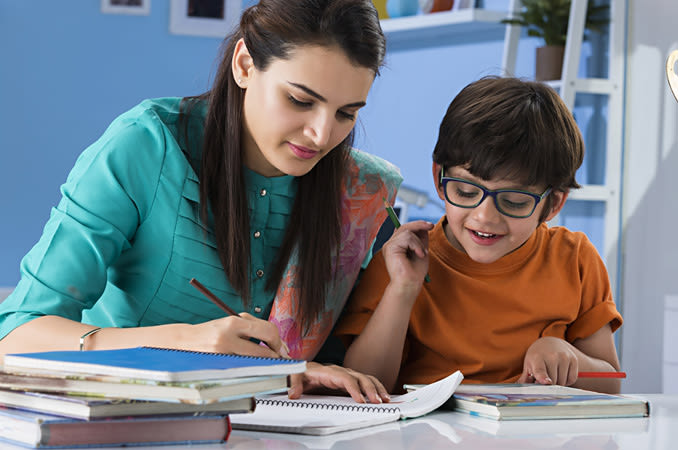Commonly known as short-sightedness or nearsightedness, Myopia is a growing problem that occurs in childhood. Studies predict that nearly half of the population in the world will get their vision affected by high myopia by 2050.
Myopia which mostly starts developing in childhood by lifestyle, family history or both is a condition of eyeballs growing too long to make distance vision blurry. The condition tends to worsen as the child’s eyes continue to grow as they get older and impact the everyday health and future eye health.
Ophthalmology researchers have found hope in managing myopia during childhood with improved strategies. Children who develop myopia in early childhood, especially before the age of 10 are at higher risk of progressing into high myopia. Childhood eye care is nowadays focusing primarily on Myopia management or Myopia treatment as many parents are concerned about slowing down the onset and worsening of Myopia in early adulthood.
Listed below are some important measures to prevent or slow down the onset and growth of Myopia in children:
Put the devices away
Studies have shown that the rise in myopia cases are primarily due to changes in the lifestyle of children. Today’s children are centred around gadget screens for education and infotainment from a very young age. It isn’t practical to advise children to keep their eyes away from gadget screens, but parents have to limit children’s screen time and ensure regular intervals.
Send kids outside
In research conducted in Boston, the progression of myopia was found to be 3 to 4 times faster in winter than in summer. Scientists suggest that the cause of myopia’s progression can also be due to the light exposure levels. Parents should prioritize letting children engage in outdoor activities whenever possible so that they can get a quick recovery from a lot of time indoors exposed to blue light. Various meta-analysis data shows that kids who spend more than an average of 3.7 hours per week outdoors than those with myopia had normal vision or hyperopia. This shows that the onset and progress of myopia can be reduced by 15 to 40 per cent by increasing the outdoor activity of children. The components in sunlight will activate the amount of Vitamin D in children, thus impacting the healthy growth of the eye. While staying outdoors kids will be engaged in more distant eyesight, thus reducing the strain for their eyes.
Ask your doctor about ways to manage myopia
Many eye specialists are prescribing regular glasses and contact lenses for children for their clear vision but they don’t help in the prevention of myopia. Children should need stronger prescriptions for spectacles and eye drops as they continue to grow older in order to slow the progression of myopia.
Myopia treatment is achieved by prescribing atropine eye drops to slow down myopia or special types of spectacles and contact lenses. At Dr Shalini Jain’s Samyak Eye Clinic in Ghaziabad, children are mostly prescribed ortho-k lenses and multifocal contact lenses among a few other types of contact lenses depending on children’s eye health condition. Ortho-k lenses are prescribed for slowing down the development of myopia while children with high myopia are prescribed multifocal contact lenses to slow the progression of shortsightedness as an effective treatment option.
Theories
The visual value of children spending more time outdoors has been backed by many studies. It is argued that the growth of the eye and myopia will be slowed down by the light towards the spectrum’s UV end. It is also assumed that the differences in the defocus across the visual field can impact the distance of vision indoor and outdoor.
Light-dopamine
Among all the theories the light-dopamine theory is looked up most which state that bright outdoor helps the retina to release dopamine, which in turn signals the sclera to inhibit axial growth. Laboratory experiment using an animal model of myopia in chicken and non-human primates, their protective effectiveness against myopia was blocked when the effects of dopamine were blocked with a dopamine antagonist. This hints at the importance of optimal dopamine levels in preventing myopia.
With the changes in children’s lifestyles and increased visual stress, it is important to start myopia management for children as early as possible. Studies indicate that blurred distance vision and glasses prescription will continue to worsen when a child develops myopia early. There is no time to wait to start myopia management as the condition of every child will progress or worsen with the onset.
According to Dr Shalini, a child’s eye test needs to be done for the first time between the age of 6 months or 1 year, once in 6 months till the age of 19 and then followed by annual eye exams. She says that many parents at her eye centre near Vaishali still think that their child is too young to start a myopia control strategy. Parents won’t have a problem with getting their kids to have eye drops to slow down myopia or wear their glasses or contact lenses, once they are aware of the consequences. At Dr Shalini Jain’s Samyak eye care clinic near Vaishali children get the right myopia treatment depending on their age, eye condition, family history and lifestyle. Dr Shalini recommends contact lenses to be safe for children, especially between the age of 8-12.


